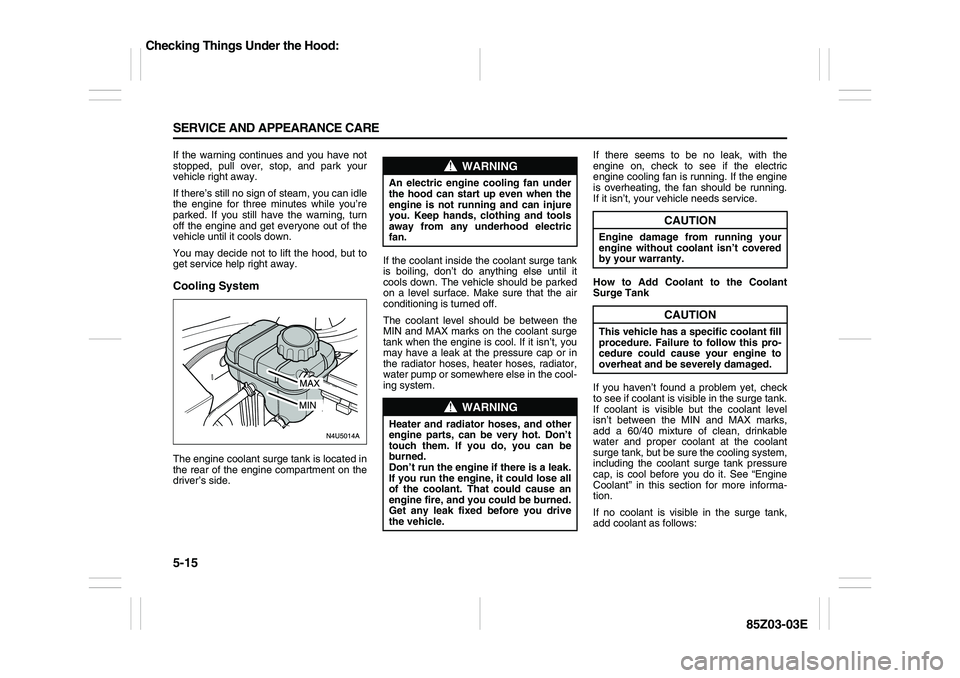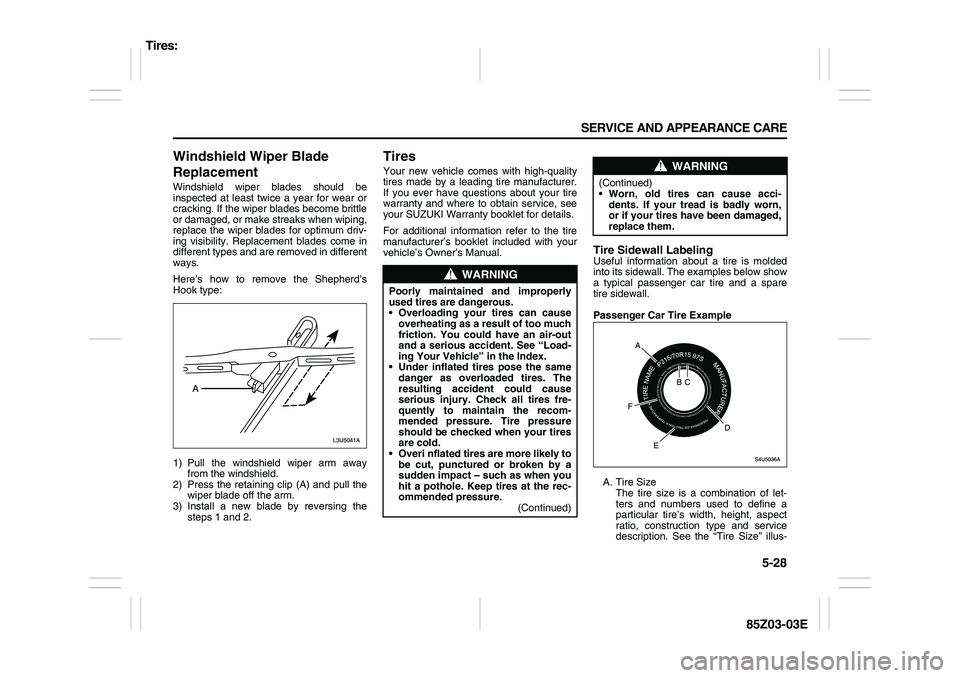2007 SUZUKI FORENZA heating
[x] Cancel search: heatingPage 159 of 225

5-15 SERVICE AND APPEARANCE CARE
85Z03-03E
If the warning continues and you have not
stopped, pull over, stop, and park your
vehicle right away.
If there’s still no sign of steam, you can idle
the engine for three minutes while you’re
parked. If you still have the warning, turn
off the engine and get everyone out of the
vehicle until it cools down.
You may decide not to lift the hood, but to
get service help right away.Cooling SystemThe engine coolant surge tank is located in
the rear of the engine compartment on the
driver’s side.If the coolant inside the coolant surge tank
is boiling, don’t do anything else until it
cools down. The vehicle should be parked
on a level surface. Make sure that the air
conditioning is turned off.
The coolant level should be between the
MIN and MAX marks on the coolant surge
tank when the engine is cool. If it isn’t, you
may have a leak at the pressure cap or in
the radiator hoses, heater hoses, radiator,
water pump or somewhere else in the cool-
ing system.If there seems to be no leak, with the
engine on, check to see if the electric
engine cooling fan is running. If the engine
is overheating, the fan should be running.
If it isn’t, your vehicle needs service.
How to Add Coolant to the Coolant
Surge Tank
If you haven’t found a problem yet, check
to see if coolant is visible in the surge tank.
If coolant is visible but the coolant level
isn’t between the MIN and MAX marks,
add a 60/40 mixture of clean, drinkable
water and proper coolant at the coolant
surge tank, but be sure the cooling system,
including the coolant surge tank pressure
cap, is cool before you do it. See “Engine
Coolant” in this section for more informa-
tion.
If no coolant is visible in the surge tank,
add coolant as follows:
WARNING
An electric engine cooling fan under
the hood can start up even when the
engine is not running and can injure
you. Keep hands, clothing and tools
away from any underhood electric
fan.
WARNING
Heater and radiator hoses, and other
engine parts, can be very hot. Don’t
touch them. If you do, you can be
burned.
Don’t run the engine if there is a leak.
If you run the engine, it could lose all
of the coolant. That could cause an
engine fire, and you could be burned.
Get any leak fixed before you drive
the vehicle.
CAUTION
Engine damage from running your
engine without coolant isn’t covered
by your warranty.
CAUTION
This vehicle has a specific coolant fill
procedure. Failure to follow this pro-
cedure could cause your engine to
overheat and be severely damaged.
Checking Things Under the Hood:
Page 172 of 225

5-28 SERVICE AND APPEARANCE CARE
85Z03-03E
Windshield Wiper Blade
ReplacementWindshield wiper blades should be
inspected at least twice a year for wear or
cracking. If the wiper blades become brittle
or damaged, or make streaks when wiping,
replace the wiper blades for optimum driv-
ing visibility. Replacement blades come in
different types and are removed in different
ways.
Here’s how to remove the Shepherd’s
Hook type:
1) Pull the windshield wiper arm away
from the windshield.
2) Press the retaining clip (A) and pull the
wiper blade off the arm.
3) Install a new blade by reversing the
steps 1 and 2.
TiresYour new vehicle comes with high-quality
tires made by a leading tire manufacturer.
If you ever have questions about your tire
warranty and where to obtain service, see
your SUZUKI Warranty booklet for details.
For additional information refer to the tire
manufacturer’s booklet included with your
vehicle’s Owner’s Manual.
Tire Sidewall LabelingUseful information about a tire is molded
into its sidewall. The examples below show
a typical passenger car tire and a spare
tire sidewall.
Passenger Car Tire Example
A. Tire Size
The tire size is a combination of let-
ters and numbers used to define a
particular tire’s width, height, aspect
ratio, construction type and service
description. See the “Tire Size” illus-
WARNING
Poorly maintained and improperly
used tires are dangerous.
Overloading your tires can cause
overheating as a result of too much
friction. You could have an air-out
and a serious accident. See “Load-
ing Your Vehicle” in the Index.
Under inflated tires pose the same
danger as overloaded tires. The
resulting accident could cause
serious injury. Check all tires fre-
quently to maintain the recom-
mended pressure. Tire pressure
should be checked when your tires
are cold.
Overi nflated tires are more likely to
be cut, punctured or broken by a
sudden impact – such as when you
hit a pothole. Keep tires at the rec-
ommended pressure.
(Continued)
WARNING
(Continued)
Worn, old tires can cause acci-
dents. If your tread is badly worn,
or if your tires have been damaged,
replace them.
Tires:
Page 195 of 225

5-51 SERVICE AND APPEARANCE CARE
85Z03-03E
Engine Compartment Fuse Block
The engine compartment fuse block is
located on the driver’s side of the vehicle,
near the battery. See “Engine Compart-
ment Overview” in this section for more
information on location.
To access the fuses, press in the side flaps
to release the cover.
To reinstall the cover, push until it is
secure. Fuses Usages
AIRBAG Air Bag
WPR Wiper
RADIO/CLK Radio/Clock
ECMEngine Control
Module
AIRBAGOccupation Classifi-
cation Sensor
AUX LTR Extra Jack
TRN SIG LAMPS Turn Signal Lamps
ABSAntilock Brake
System
LTR Cigar Lighter
CLSTR, BTSICluster, BTSI
Solenoid
RKERemote keyless
Entry
BCK/UP Back-up
BLANK Not Used
TCMTransmission
Control Module
Fuses Usages
ENG FUSE BOX,
DRLEngine Fuse box,
Daytime Running
Light
HAZRD LAMPS Hazard Lamps
A/C, CLK A/C Switch, Clock
HVACHeating, Ventilation
and Air Conditioning
RKERemote Keyless
Entry
RADIO Radio
S/ROOF Sunroof
DLC Data link Connector
SPARE Spare
Electrical System:
Page 221 of 225

8-2 INDEX
85Z03-03E
Doing Your Own Service Work
...........................................5-1
Door Ajar Light
....................................................................3-26
Door Ajar Reminder
.............................................................2-5
Door Locks
...........................................................................2-4
Doors and Locks
.................................................................2-4
Driver Position
.....................................................................1-7
Driver Seat Height Adjuster
................................................1-2
Driving at Night
....................................................................4-8
Driving in Rain and on Wet Roads
.....................................4-9
Drunken Driving
...................................................................4-1
EElectrical System
.................................................................5-49
Emission Compliance Label (for U.S.A.)
...........................7-2
Engine Air Cleaner/Filter
.....................................................5-9
Engine Compartment Overview
.........................................5-6
Engine Coolant
....................................................................5-12
Engine Coolant Temperature Gauge
.................................3-22
Engine Exhaust
....................................................................2-20
Engine Oil
.............................................................................5-7
Engine Overheating
.............................................................5-14
Engine Serial Number .........................................................7-1
Exterior Lamps
....................................................................3-9
FFilling a Portable Fuel Container
.......................................5-4
Filling Your Tank
.................................................................5-2
Finish Damage
.....................................................................5-48
Floor Net (Wagon only)
.......................................................2-24
Fog Lamp Light
....................................................................3-24
Folding Rear Seat ................................................................1-4
Freeway Driving
...................................................................4-11
Front Armrest Storage Area
...............................................2-23Front Fog Lamps
................................................................. 5-25
Front Seats
.......................................................................... 1-1
Front Sidemarker Lamps
.................................................... 5-24
Front Storage Area
............................................................. 2-23
Front Turn Signal Lamps
................................................... 5-24
Fuel
....................................................................................... 5-1
Fuel Gauge
.......................................................................... 3-25
Fuels in Foreign Countries
................................................ 5-2
Fuses and Circuit Breakers ............................................... 5-50
GGasoline Octane
.................................................................. 5-1
General Information
............................................................ 6-1
Glossary of Tire Terminology
............................................ 5-31
Glove Box
............................................................................ 2-22
HHalogen Bulbs
..................................................................... 5-23
Hazard Warning Flashers
................................................... 3-3
Head Restraints
................................................................... 1-3
Headlamp Aiming ................................................................ 5-23
Headlamp Wiring ................................................................. 5-49
Headlamps
........................................................................... 5-24
Highbeam On Light
............................................................. 3-25
Highway Hypnosis .............................................................. 4-12
Hill and Mountain Roads
.................................................... 4-12
Hold Mode Light
.................................................................. 3-22
Hood Release
...................................................................... 5-4
Horn
...................................................................................... 3-3
How Does an Air Bag Restrain?
........................................ 1-33
How to Wear Safety Belts Properly ................................... 1-7
Hydraulic Clutch
................................................................. 5-12